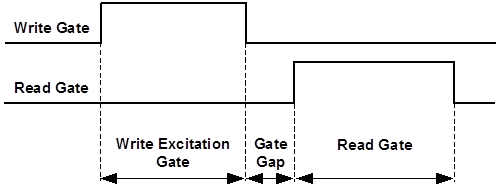Write-Excited Sectored Amplitude (WESA) Test Package
- Separate Amplitude Asymmetry Stability Test
- Triple Amplitude Asymmetry Stability Test
- Write Induced Instability Test
- Pole Erasure Test

The WESA tests fall into two groups:
- Three tests (all except Pole Erasure) induce the head with write excitation and measure the resulting fluctuations of the read-back signal. The tests use the Write Excitation Mode. In this mode, the read operation follows the write operation without changing the write-to-read offset for one sector. The write and read gates do not overlap, as it is shown in the picture below. The write current induces the head, but the write operation has little influence on the data read from the track because of the write-to-read offset. Some electrical effects on the induced head, however, will cause fluctuations in the read-back signal.

- The Pole Erasure test measures the erasure effect of the head pole on media magnetization near the end of the write gate. This erasure effect occurs when the write current is switched off but the head continues erasing the track. Similar to the previous tests, this test uses non-overlapping write and read gates within each sector, but it does not induce the head with the write excitation. The write-to-read offset is enabled, so that the write and read operations are performed at the same position during different revolutions.
WESA Test Package
The test package includes the following tests:
- Separate Amplitude Asymmetry Stability Test measures the read-back signal amplitude fluctuations caused by a write excitation. The user specifies write and read gates, preconditioning, write options, and excitation pattern. The test reports statistics based on the sector-to-sector variance of the following measurements: zero-to-positive-peak average amplitude, zero-to-negative-peak average amplitude, peak-to-peak average amplitude, and amplitude asymmetry.
- Triple Amplitude Asymmetry Stability Test compares the amplitude asymmetry variation for the three consecutive measurements executed with different data pattern, excitation pattern, and/or read-bias current.
- Write Induced Instability Test compares the sector average amplitude for two different excitation patterns. The test makes two measurements for each of the patterns.
- Pole Erasure Test measures the erasure effect of the head pole. The test performs consecutive write and read operations along the same track with enabled write-to-read offset. The spinstand will move the magnetic head to the specified offset before the read operation starts and will return the head back to the original offset before the write operation.
Software Requirements
The Write-Excited Sectored Amplitude (WESA) test package is available for WITE32 version 3.30 and later. The package requires a license.
Hardware Requirements
The WESA test package is compatible with the RWA-2000 series. The RWA-2585 and
RWA-2550 testers may require an upgrade.

